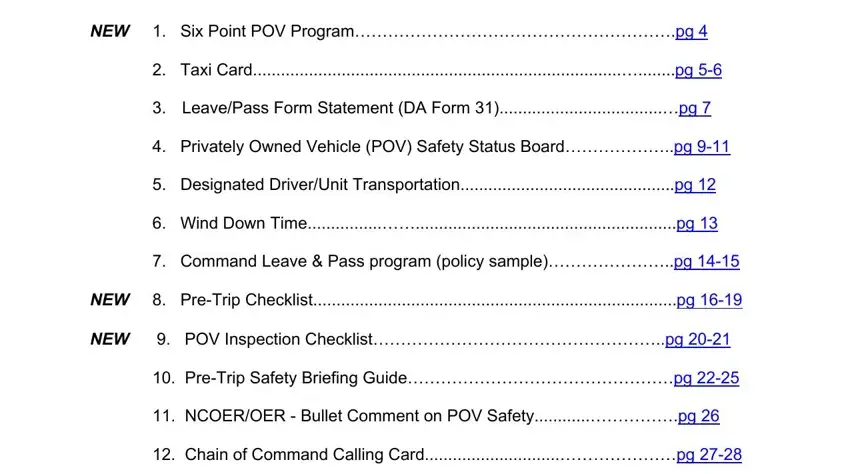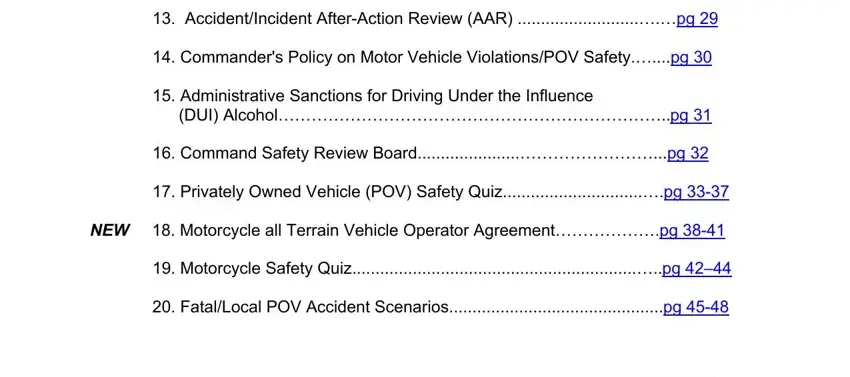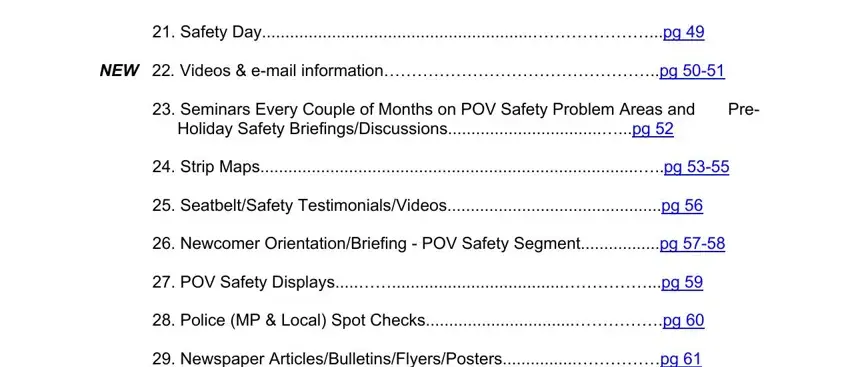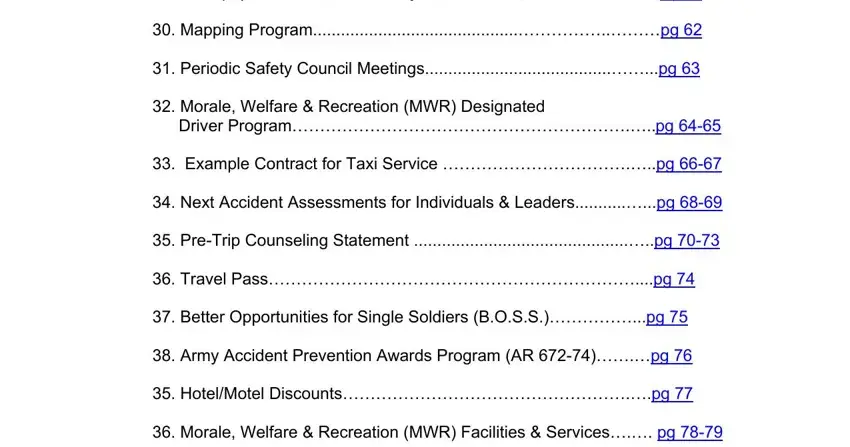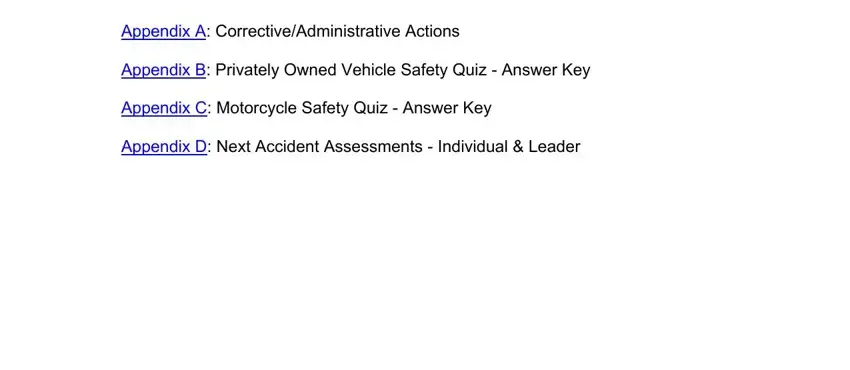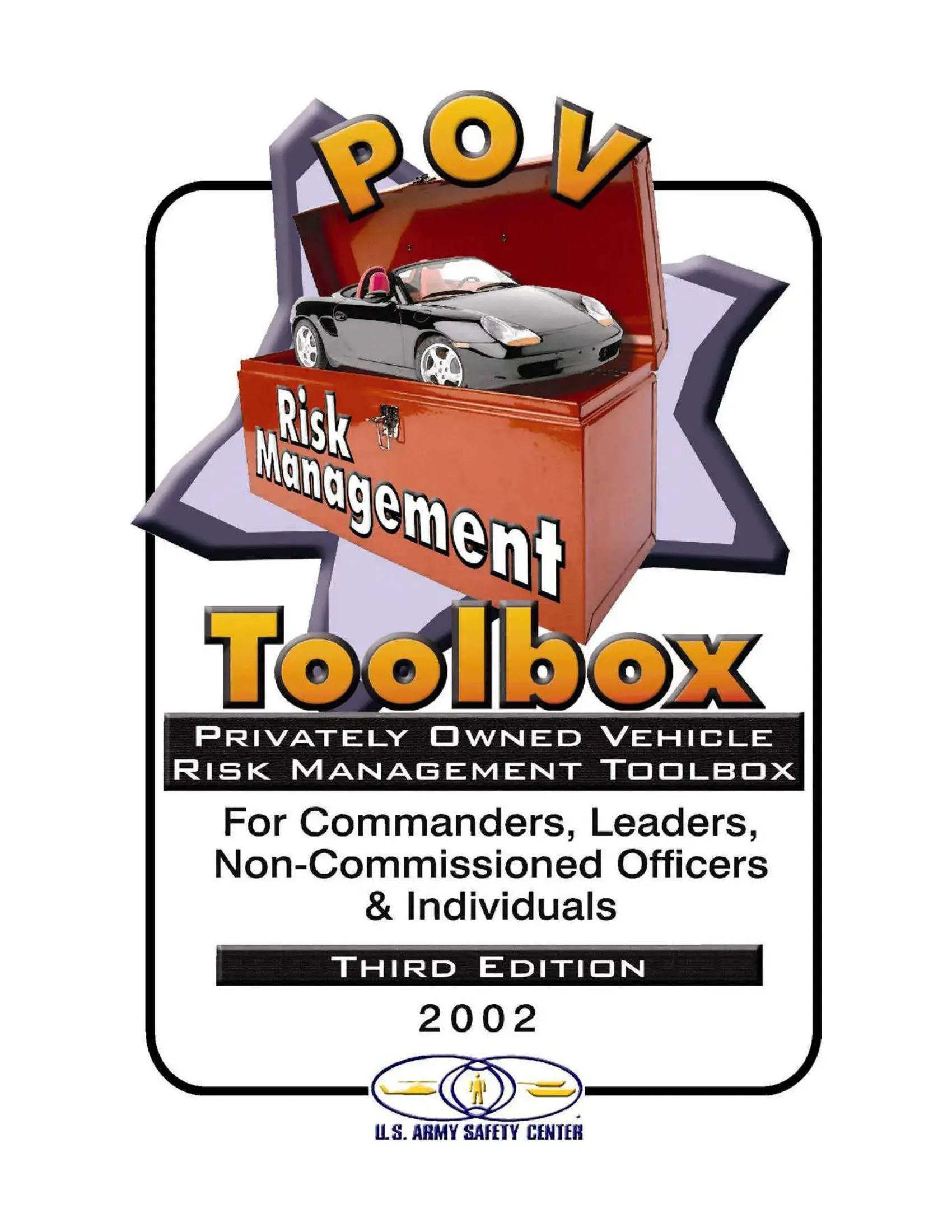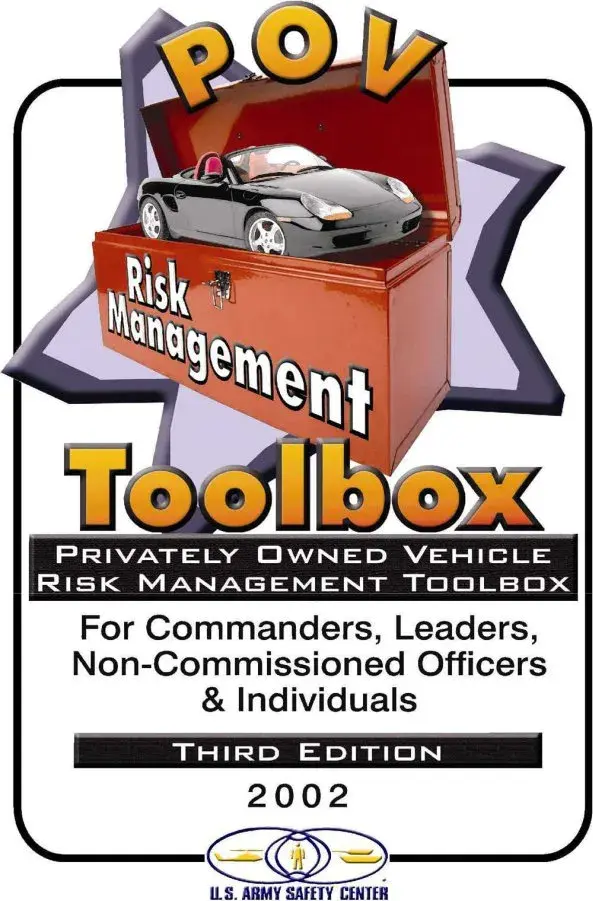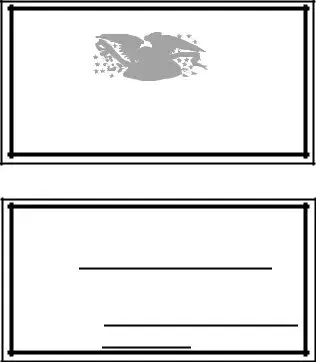SUMMARY of CHANGE
New materials includes--
oSix Point POV Program - CSA Directed that this Six Point Program be used in every unit. It is the minimum standard. A copy of the 6-point POV Program has been included.
oPOV inspection checklist - Checkout this great new tool developed from a review of all the best military and public (State) programs.
oPre-trip checklist – Checklist designed to be completed for all planned trips outside the immediate local area when soldiers are going on leave/pass.
oMotorcycle operator agreement - A sample “Motorcycle Operator/All Terrain Vehicle (ATV) Requirements and Individual Responsibilities Agreement” to be signed by the individual soldier operating or intending to operate a motorcycle or ATV
oVideo information - Several talented country music artists have joined up in the Army’s campaign to prevent soldier deaths in POV accidents. Five short public service video clips are now available
PRIVATELY OWNED VEHICLE (POV)
RISK MANAGEMENT TOOLBOX FOR COMMANDERS, LEADERS, NON-
COMMISSIONED OFFICERS AND INDIVIDUALS
Contents
NEW 1. Six Point POV Program………………………………………………….pg 4
2.Taxi Card...............................................................................…........pg 5-6
3.Leave/Pass Form Statement (DA Form 31)...................................…pg 7
4.Privately Owned Vehicle (POV) Safety Status Board………………..pg 9-11
5. Designated Driver/Unit Transportation |
..............................................pg 12 |
6.Wind Down Time................……........................................................pg 13
7.Command Leave & Pass program (policy sample)…………………..pg 14-15
NEW |
8. |
Pre-Trip Checklist |
..............................................................................pg 16-19 |
NEW |
9. |
POV Inspection Checklist……………………………………………..pg 20-21 |
10.Pre-Trip Safety Briefing Guide…………………………………………pg 22-25
11.NCOER/OER - Bullet Comment on POV Safety............…………….pg 26
12.Chain of Command Calling Card.............................…………………pg 27-28
13.Accident/Incident After-Action Review (AAR) ..........................….…pg 29
14.Commander's Policy on Motor Vehicle Violations/POV Safety.…....pg 30
15.Administrative Sanctions for Driving Under the Influence
(DUI) Alcohol……………………………………………………………..pg 31
16.Command Safety Review Board......................……………………...pg 32
17.Privately Owned Vehicle (POV) Safety Quiz..............................….pg 33-37
NEW 18. Motorcycle all Terrain Vehicle Operator Agreement……………….pg 38-41
19. |
Motorcycle Safety Quiz.............................................................…..pg 42–44 |
20. |
Fatal/Local POV Accident Scenarios |
..............................................pg 45-48 |
21. |
Safety Day..........................................................…………………...pg 49 |
NEW 22. Videos & e-mail information…………………………………………..pg 50-51 |
23. |
Seminars Every Couple of Months on POV Safety Problem Areas and Pre- |
|
Holiday Safety Briefings/Discussions.................................…...pg 52 |
24.Strip Maps.................................................................................…..pg 53-55
25.Seatbelt/Safety Testimonials/Videos..............................................pg 56
26.Newcomer Orientation/Briefing - POV Safety Segment.................pg 57-58
27.POV Safety Displays.....…….....................................……………...pg 59
28.Police (MP & Local) Spot Checks................................…………….pg 60
29.Newspaper Articles/Bulletins/Flyers/Posters................……………pg 61
30.Mapping Program............................................……………..………pg 62
31.Periodic Safety Council Meetings........................................……...pg 63
32.Morale, Welfare & Recreation (MWR) Designated
Driver Program…………………………………………………….…..pg 64-65
33.Example Contract for Taxi Service …………………………….…..pg 66-67
34.Next Accident Assessments for Individuals & Leaders...........…...pg 68-69
35.Pre-Trip Counseling Statement ..............................................…..pg 70-73
36.Travel Pass…………………………………………………………....pg 74
37.Better Opportunities for Single Soldiers (B.O.S.S.)……………...pg 75
38.Army Accident Prevention Awards Program (AR 672-74)…….…pg 76
35.Hotel/Motel Discounts…………………………………………….….pg 77
36.Morale, Welfare & Recreation (MWR) Facilities & Services….…. pg 78-79
Appendix A: Corrective/Administrative Actions
Appendix B: Privately Owned Vehicle Safety Quiz - Answer Key
Appendix C: Motorcycle Safety Quiz - Answer Key
Appendix D: Next Accident Assessments - Individual & Leader
CSA DIRECTED THAT THIS SIX POINT PROGRAM BE USED IN EVERY UNIT. IT IS THE MINIMUM STANDARD. THE MODEL POV SAFETY PROGRAM REQUIRES:
1.COMMAND EMPHASIS: POSITIVE LEADERSHIP AT ALL LEVELS IS IMPERATIVE. LEADER EMPHASIS ON POV SAFETY MUST BE UNRELENTING. OUR JUNIOR OFFICERS AND NON-COMMISSIONED OFFICERS SEE THEIR SOLDIERS EVERY DAY. THEY SHOULD KNOW WHERE THEIR SOLDIERS GO, WHAT THEY DO, AND THEN ASSERT POSITIVE INFLUENCE ON HOW, WHEN, AND WHERE THEY OPERATE THEIR POVS.
2.DISCIPLINE: OUR JUNIOR LEADERS WORK WITH THEIR SOLDIERS DAILY AND KNOW THEM WELL. SOLDIERS SOMETIMES TELEGRAPH SIGNALS THAT TRANSLATE LATER INTO ACCIDENTS. NEGATIVE BEHAVIOR SUCH AS TRAFFIC OFFENSES, ALCOHOL ABUSE, MISCONDUCT, AND POOR PERFORMANCE OFTEN ARE INDICATORS OF POTENTIAL POV ACCIDENT VICTIMS. IDENTIFY "AT RISK" SOLDIERS; COUNSEL THEM; TAKE PROACTIVE MEASURES TO MODIFY THEIR RISKY BEHAVIOR.
3.RISK MANAGEMENT: USE RISK MANAGEMENT. IDENTIFY HAZARDS ASSOCIATED WITH POV OPERATIONS; ASSESS THE HAZARDS; MAKE DECISIONS TO CONTROL THEM; IMPLEMENT THE CONTROLS; AND SUPERVISE EXECUTION. THE DIRECTOR OF ARMY SAFETY HAS PREPARED A POV RISK MANAGEMENT TOOLBOX FOR COMMANDERS AND LEADERS. THIS TOOLBOX PROVIDES A COMPREHENSIVE SET OF TOOLS AND CONTROLS THAT HAVE PROVED SUCCESSFUL THROUGHOUT OUR ARMY. THE TOOLBOX IS AVAILABLE AT HTTP://SAFETY.ARMY.MIL/PAGES/POV/INDEX.HTML. USE IT. MAKE IT AVAILABLE TO LEADERS AT ALL LEVELS.
4.STANDARDS: SET HIGH AND UNMISTAKABLE STANDARDS. ENFORCE THEM. FOLLOW ARMY REGULATORY TRAFFIC STANDARDS. BE UNCOMPROMISING ON THE USE OF SEATBELTS AND MOTORCYCLE SAFETY EQUIPMENT. EDUCATE SOLDIERS ON THE RISKS OF SPEED, FATIGUE AND USE OF ALCOHOL. CONDUCT MANDATORY POV SAFETY INSPECTIONS AND RANDOM ROADSIDE CHECKS. EMPHASIZE THE USE OF DESIGNATED DRIVERS FOR SOCIAL EVENTS.
5.PROVIDE ALTERNATIVES: PROVIDE ALTERNATIVES FOR SOLDIERS TO DRIVING POVS. SCHEDULE ACTIVITIES ON POST TO KEEP SOLDIERS ON POST AND OFF THE ROAD. KEEP GYMS, RECREATION CENTERS AND OTHER PLACES SOLDIERS USE OFF-DUTY OPEN LATER. THESE SAME MEASURES ALSO CAN PROVIDE ALTERNATIVES TO ALCOHOL USE. LOOK FOR TRANSPORTATION ALTERNATIVES AS WELL. PROMOTE USE OF ALTERNATE TRANSPORTATION METHODS TO POV USE. PROMINENTLY POST PUBLIC TRANSPORTATION SCHEDULES. WHERE POSSIBLE, USE MORALE, WELFARE, AND RECREATION (MWR) SERVICES TO PROVIDE BUSES OR VANS TO TRANSPORT SOLDIERS TO THE PLACES THEY GO WHEN OFF-DUTY. ARRANGE REDUCED HOTEL RATES IN NEARBY COMMUNITIES TO ENCOURAGE SOLDIERS TO REMAIN OVERNIGHT ON WEEKENDS AND STAY OFF THE HIGHWAYS LATE AT NIGHT.
6.COMMANDER'S ASSESSMENT: FOLLOWING EVERY FATAL AND SERIOUS INJURY POV ACCIDENT, COMMANDERS WILL CONDUCT AN ASSESSMENT OF THE ACCIDENT WITH THE INVOLVED SOLDIER'S CHAIN OF COMMAND. DETERMINE WHAT HAPPENED, WHY IT HAPPENED, AND HOW IT COULD HAVE BEEN PREVENTED. IMPLEMENT CORRECTIVE AND PREVENTIVE MEASURES. PUBLICIZE LESSONS LEARNED.
POC: Mr. Brown ( brownj@safetycenter.army.mil )
TAXI CARD
|
1/13 IN TAXI CARD |
|
BeenDrinkingor TooTiredToDrive? |
|
Call aTaxi andArriveALIVE!! |
|
SMITHVILLE - 678-1000 (24 hours) |
|
CARVER - 842-2100 (After 2400 - 842-3200) |
|
DENTON - 456-7500 (After 2000 - 456-7600) |
|
WESTON - 234-4202 (24 hours) |
EXAMPLE |
Front |
|
Card is valid for individual listed & one
Taxi Ride to residence listed below.
NAME: John Doe
ADDRESS: |
123 Jones Street |
Weston, AL
Taxi Fare
Back
1.PURPOSE: Provides soldier with an alternative to driving after drinking or while too fatigued to drive safely. Taxi card is valid for one free taxi ride home.
2.SIZE: Business card.
3.CONTENTS:
a.Unit name/insignia.
b.Phone numbers for taxi companies in each surrounding community.
c.Reverse side should have soldier's name and address so that taxi driver knows where to take soldier. This provides information that soldier may not be able to remember if he is very drunk/fatigued and prevents abuse/misuse of card. It also provides a means of returning the card to the soldier for re-use at a later time (card re-circulates back to soldier after taxi company turn in).
d.National Guard/Reserves - The reverse side should have the soldier’s name and the address of the Armory where the soldier is currently attending drill.
4.USE:
a.Soldier who has been drinking or is too fatigued to drive safely surrenders card to local taxi company for free ride home.
b.No retaliation for use of card.
c.Unit can require soldier to pay funds back later (reimburse the fund within 15 days of
use).
d.After taxi company turn in, card is re-circulated back to soldier for re-use.
e.Soldiers can be provided with cards and briefed on their use during unit in- processing.
f.Periodic checks are suggested to ensure soldiers have Taxi Cards with them at all times (e.g., prior to long weekends/pass)
g.National Guard/Reserves - Provide CQ/Duty Officer to ensure 24 hour access to the Armory in case a soldier needs to use the Taxi Card during drill weekends when drills are scheduled at the Armory.
5.REQUIREMENTS:
a.Coordination with Taxi Companies. Requires coordination with your installation/organization’s Contracting Directorate to determine requirements for contracting taxi services and with local taxi companies and agreement by unit to pay fees. Fees should be collectable from BN POC whose name; phone number and location are provided to taxi companies. Taxi companies will not be likely to participate if they have to track down individual soldiers for payment. Remind taxi companies that having their names/numbers on the card are good free advertisement for them.
b.Unit Funds. Use of unit funds will be required (at least initially) to ensure money is available when needed. Reimbursement of funds by soldier within 15 days after use can be required.
c.Taxi Cards. Consider providing each soldier with two cards. If soldier must give the card to the taxi driver, he will be without one (if needed) until it is cashed in by taxi driver and returned to soldier.
LEAVE/PASS FORM STATEMENT
(DA FORM 31)
EXAMPLE STATEMENT
You will be on leave/pass from ____________ until
_____________. You are scheduled to be back at work
on _____________. You should plan to be in the
first formation of the day in a ready to work condition. This means you must plan your return travel so you arrive with time for adequate rest before formation. You are required to have this DA Form 31 in your possession at all times. If an emergency or other situation arises which might prevent you from returning safely to work on time, contact one of the individuals listed below and arrangements will be made to ensure your safe return.
SAMPLE
BN SDNCO |
334-321-2888 |
SECTION CHIEF |
334-678-8765 |
PLATOON SERGEANT |
334-678-6543 |
1SG |
334-678-4321 |
CSM |
334-678-9876 |
RED CROSS |
334-321-1234 |
Don’t Drink and Drive
1.PURPOSE: Informs soldier he/she is expected to be ready to work after returning from leave/pass and provides instructions for emergencies/situations that might prevent a safe, on-time return.
2.STATEMENT CONTENTS:
a.Expected ready-to-work condition after return from leave/pass.
b.Calling instructions for delayed return.
3.USE:
a.Statement should be in Block 17 of DA Form 31 (Sep 93).
b.All leave/pass forms should include such a statement, and soldiers should be required to have the DA Form 31 in their possession at all times while on leave/pass. This will ensure that phone numbers are always available.
c.If soldier's return is delayed, supervisor can arrange to charge additional leave time for extension or schedule makeup work.
d.If strip maps for the local area's frequently visited resorts/recreation areas have been developed (see Strip Map page), provide copies to soldiers when DA Form 31 indicates one of these destinations.
